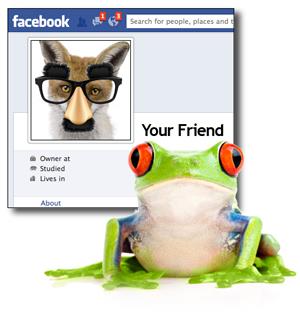FEBRUARY 2013: Do you know how delicious your Facebook profile is to cyber crooks hungry for personal information? It’s like an all-you-can-eat data buffet — that’s free!
You tell your Facebook friends where you live and work, which school you went to, who your friends are, where you sunbathed on your last vacation, your pets’ names, your kids’ birthdays … even a comment like “I’m so frustrated with Comcast!!” can inadvertently open the door to identity theft.
And because we tend to let our guards down when it comes to social media, crooks are going to try everything to be your “friends.” Including pretending to be someone you know by using a fake Facebook account with a real profile photo they downloaded.
So what’s a smart frog to do? Follow these 10 tips:
1. Don’t accept friend requests from people you don’t know. Really, don’t do it. If you’re unsure about the person, send a message asking for a reminder about how the two of you met. Just because they claim to have gone to your high school doesn’t mean they did, or that they need to be your friend — crooks went to high school! The request could also be coming from a bot (robot) that sends out hundreds of friend requests as part of a phishing scheme.
2. Keep in mind your friends may not practice “safe friending.” Just because your friends accepted someone’s request doesn’t mean this person is for real. Studies show that 41% (or more) of people with Facebook accounts accept requests from people they don’t know, usually because they have a friend in common and sometimes because not accepting the request feels rude. In fact, there are entire friend networks of fake profiles all vouching for each other.
3. Visit a new friend’s profile to see if anything looks fishy. Is the profile new? How’s the grammar? Are most of the friends global rather than local? Are they tagged in photos?
4. If you’re not sure about people you’ve already accepted as friends, de-friend them or add them to your Restricted list. Both accomplish basically the same thing. Placing someone on your Restricted list means they only see the information that you make public. Friends are not notified that they’re on the list, and you can take them off the list at any time.
5. If you find a profile that is clearly bogus, Block it immediately. While Facebook reports it has hundreds of people on staff to locate and eliminate fraud, it told the Securities and Exchange Commission that an estimated 83 million of its 955 million users (or 8.7%) were fake, duplicates or “undesirable.” That was June 2012. Today there a more than a billion users.
6. When a friend you don’t really know posts a link, don’t click! Most Facebook scams are attempts to spread malware — click that link and a nasty code may download into your computer.
7. When a friend you DO know posts a link that looks questionable, don’t click that either! Your friend may have been duped or their account may have been hijacked. Check out shortened links before you click.
8. Set your Inbox filtering to strict. Think of it as email — do you want to get email from just anyone? Impostors can try to trick you by pretending they’re your real friends.
9. Keep your profile private. The more people that can access your profile, the easier it is to try to scam you or hijack your Facebook identity. Check out Facebook’s Safety Center.
10. Keep up to date on Facebook privacy issues by liking this official page so updates appear in your News Feed.
While you would never intentionally share information that makes you vulnerable, smart frogs always remember that any piece of information you share could be the missing link to your identity. So never, ever respond to requests for your date of birth, passwords, login information, social security number, credit card number, expiration date or anything else that makes you YOU.

